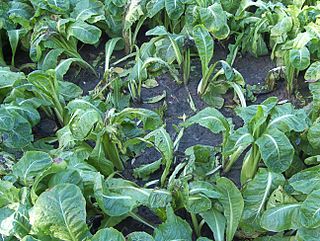Pseudomonas chlororaphis is a bacterium used as a soil inoculant in agriculture and horticulture. It can act as a biocontrol agent against certain fungal plant pathogens via production of phenazine-type antibiotics. Based on 16S rRNA analysis, similar species have been placed in its group.
Pseudomonas fragi is a psychrophilic, Gram-negative bacterium that is responsible for dairy spoilage. Unlike many other members of the genus Pseudomonas, P. fragi does not produce siderophores. Optimal temperature for growth is 30 °C, however it can grow between 0 and 35 °C. Based on 16S rRNA analysis, P. fragi has been placed in the P. chlororaphis group.
Pseudomonas avellanae is a Gram-negative plant pathogenic bacterium. It is the causal agent of bacterial canker of hazelnut. Based on 16S rRNA analysis, P. avellanae has been placed in the P. syringae group. This species was once included as a pathovar of Pseudomonas syringae, but following DNA-DNA hybridization, it was instated as a separate species. Following ribotypical analysis Pseudomonas syringae pv. theae was incorporated into this species.
"Pseudomonas blatchfordae" is a Gram-negative soil bacteria isolated from tomato pith necrosis and the common bean. It is not a validly recognized species. Based on 16S rRNA analysis, it falls within the P. fluorescens group.
Pseudomonas caricapapayae is a Gram-negative soil bacterium that is pathogenic to plants. It was originally isolated on papaya in Brazil. Based on 16S rRNA analysis, P. caricapapayae has been placed in the P. syringae group.
Pseudomonas ficuserectae is a nonfluorescent, Gram-negative, soil bacterium that causes bacterial leaf spot on a Japanese fig, from which it derives its name. Based on 16S rRNA analysis, P. ficuserectae has been placed in the P. syringae group.

Pseudomonas marginalis is a soil bacterium that can cause soft rots of plant tissues. It infects poinsettia, lettuce, and crucifers.
Pseudomonas meliae is a fluorescent, Gram-negative, soil bacterium that causes bacterial gall of the chinaberry, from which it derives its name. Based on 16S rRNA analysis, P. meliae has been placed in the Pseudomonas syringae group. Genotypic characteristics of the causal agent of chinaberry gall were determined by Aeini and Taghavi.
Pseudomonas mendocina is a Gram-negative environmental bacterium that can cause opportunistic infections, such as infective endocarditis and spondylodiscitis, although cases are very rare. It has potential use in bioremediation as it is able to degrade toluene. Based on 16S rRNA analysis, P. mendocina has been placed in the P. aeruginosa group.
Pseudomonas flavescens is a Gram-negative bacterium that causes blight cankers on walnut trees. Based on 16S rRNA analysis, P. flavescens has been placed in the P. aeruginosa group.
Pseudomonas mosselii is a Gram-negative, rod-shaped, bacterium clinically isolated in France. Based on 16S rRNA analysis, P. mosselii has been placed in the P. putida group.
Pseudomonas synxantha is a fluorescent rhizosphere bacterium with nematicidal properties. Based on 16S rRNA analysis, P. synxantha has been placed in the P. fluorescens group.
Pseudomonas straminea is a Gram-negative, rod bacterium that includes strains formerly identified as P. ochracea. Based on 16S rRNA analysis, P. straminea has been placed in the P. aeruginosa group.
Pseudomonas mediterranea is a bacterium, similar to P. corrugata, that causes tomato pith necrosis. For the phylogenetic analysis of P. corrugata and its closely related phytopathogenic bacterium Pseudomonas mediterranea refer to Trantas et al. 2015.
Pseudomonas plecoglossicida is a non-fluorescent, Gram-negative, rod-shaped, motile bacterium that causes hemorrhagic ascites in the ayu fish, from which it derives its name. Based on 16S rRNA analysis, P. plecoglossicida has been placed in the P. putida group.
Pseudomonas orientalis is a Gram-negative, rod-shaped bacterium isolated from spring waters in Lebanon. Based on 16S rRNA analysis, P. orientalis has been placed in the P. fluorescens group.
Pseudomonas migulae is a fluorescent, Gram-negative, rod-shaped bacterium isolated from natural mineral waters in France. This bacterium has also been isolated from endophytic tissues of lodgepole pine trees growing on gravel mining sites with potential to perform biological nitrogen fixation and plant growth promotion. Based on 16S rRNA analysis, P. migulae has been placed in the P. fluorescens group.
Pseudomonas gessardii is a fluorescent, Gram-negative, rod-shaped bacterium isolated from natural mineral waters in France. Based on 16S rRNA analysis, P. gessardii has been placed in the P. fluorescens group.
Pseudomonas rhodesiae is a Gram-negative, rod-shaped bacterium isolated from natural mineral waters. Based on 16S rRNA analysis, P. rhodesiae has been placed in the P. fluorescens group.
Pseudomonas azotoformans is a Gram-negative bacterium that infects cereal grains—especially rice. Based on 16S rRNA analysis, P. azotoformans has been placed in the P. fluorescens group.
